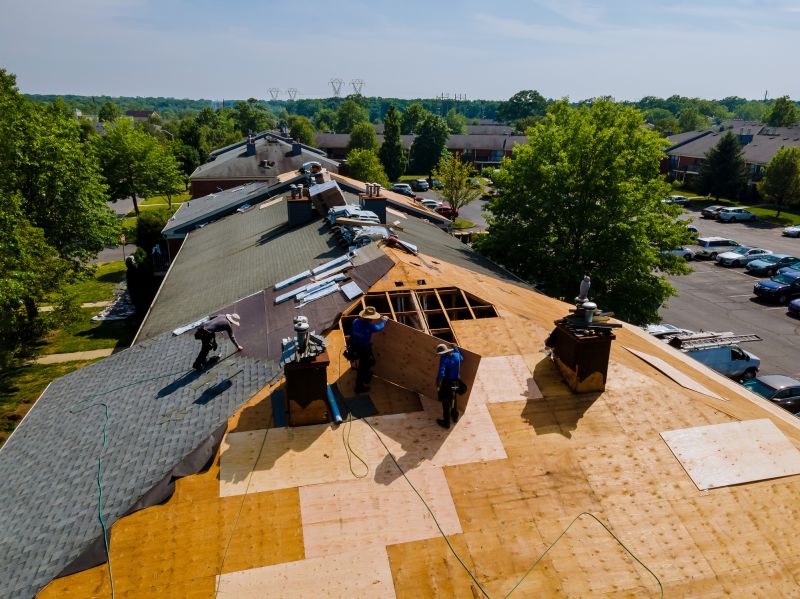Expert Picks for Roofing Installation Equipment and Supplies
Get insights into the most trusted products that simplify roofing tasks and improve project outcomes.
 Roofing installations are a critical component of building construction and maintenance, requiring a diverse array of products to ensure durability, safety, and efficiency. From the foundational materials used in roofing structures to the specialized tools and accessories needed for installation, selecting the right products can significantly impact the longevity and performance of a roof. Properly chosen materials help withstand environmental elements and provide insulation, weatherproofing, and aesthetic appeal. Whether undertaking a new roof installation or repairs, understanding the variety of available products is essential for making informed decisions.
Roofing installations are a critical component of building construction and maintenance, requiring a diverse array of products to ensure durability, safety, and efficiency. From the foundational materials used in roofing structures to the specialized tools and accessories needed for installation, selecting the right products can significantly impact the longevity and performance of a roof. Properly chosen materials help withstand environmental elements and provide insulation, weatherproofing, and aesthetic appeal. Whether undertaking a new roof installation or repairs, understanding the variety of available products is essential for making informed decisions.
Top Overall Option
Comprehensive Roofing Material Kit
A versatile roofing material kit that includes a selection of underlayments, fasteners, sealants, and basic tools. Designed for durability and ease of use, it provides a well-rounded set of products suitable for various roofing projects, making it an excellent choice for both DIY enthusiasts and professional installers.
Types of Products For Roofing Installations
Asphalt Shingles
Popular roofing material known for ease of installation and cost-effectiveness, available in various styles and colors.
Metal Roofing Panels
Durable and long-lasting panels suitable for various building types, offering a range of finishes and profiles.
Roof Underlayments
Protective layers installed beneath the primary roofing material to prevent moisture infiltration.
Roof Flashing
Metal pieces used to seal joints and edges, preventing water leaks around chimneys, vents, and valleys.
Roofing Fasteners
Specialized screws and nails designed for secure attachment of roofing materials.
Sealants and Caulks
Materials used to seal gaps and joints, enhancing waterproofing and sealing around penetrations.
Roof Vents
Ventilation products that promote airflow and help regulate temperature and moisture levels.
Roofing Membranes
High-performance sheets used in flat roofing systems for waterproofing and protection.
Insulation Materials
Insulating products that improve energy efficiency and thermal regulation of the building.
Roofing Tools
Essential hand and power tools for cutting, fastening, and installing roofing materials.
Gutters and Downspouts
Systems designed to channel water away from the roof and foundation, protecting the structure.
Roofing Adhesives
Products used to bond roofing materials securely, especially in flat roofing applications.
Skylights and Roof Windows
Windows installed in roofing to bring natural light into interior spaces.
Snow Guards
Devices installed to prevent snow and ice from sliding off the roof suddenly.
Roofing Accessories
Additional items such as ridge caps, edge trims, and decorative elements to complete the roofing system.
Popular Choices
Widely used for residential roofing, offering a variety of styles and colors.
Known for longevity and low maintenance, suitable for diverse architectural styles.
Essential for moisture protection beneath the primary roofing material.
Trending for their role in improving attic ventilation and airflow.
Popular for sealing joints, penetrations, and flashing to prevent leaks.
Common fasteners for attaching shingles and panels securely.
Frequently selected for effective water drainage and protection of building foundations.
In demand for commercial and flat roof applications, offering waterproofing solutions.
Popular for DIY projects, containing essential hand and power tools.
Commonly used for sealing around chimneys, vents, and skylights.
Trending for energy efficiency and thermal performance in roofing systems.
Popular for adding natural light to interior spaces with roof access.
The process of roofing involves multiple stages, each requiring specific products. Underlayments serve as a vital barrier against moisture, while various types of shingles or panels form the visible surface layer. Fasteners, sealants, and flashing are crucial for securing components and preventing leaks. Additionally, safety equipment and tools are indispensable for ensuring worker safety and precision during installation. With a broad spectrum of options available, it is important to consider compatibility, quality, and suitability for the specific roofing project.
Investing in quality roofing products can contribute to a more efficient installation process and a longer-lasting roof. Different climates and building types may necessitate particular materials, so understanding the characteristics of each product type can help in selecting the best fit. From traditional asphalt shingles to advanced metal roofing systems, the variety offers solutions for diverse needs and preferences. Proper selection and application of these products not only enhance the structural integrity of the roof but also support the overall safety and functionality of the building.
Key Buying Considerations
- Compatibility with existing roofing materials and structure
- Durability and lifespan of the product under local weather conditions
- Ease of installation and compatibility with your skill level
- Waterproofing and sealing capabilities to prevent leaks
- Material weight and structural load requirements
- Fire resistance ratings and safety standards
- Aesthetic options and color choices to match your building's design
- Maintenance requirements and long-term upkeep
- Availability of replacement parts and accessories
- Cost-effectiveness relative to project scope and budget
- Warranty and manufacturer support policies
- Environmental resistance such as UV stability and corrosion resistance
- Ease of handling and transportation of the products
- Compatibility with tools and equipment available
- Regulatory compliance and building code adherence
